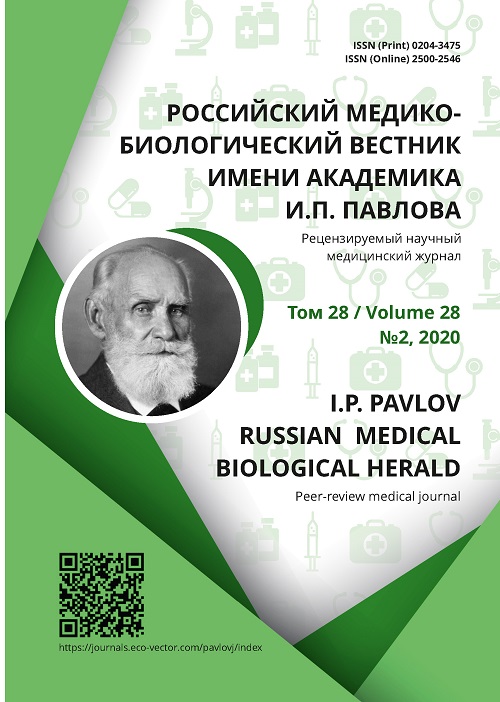子宫内甲醛对新生大鼠胸腺结构的影响
- 作者: Vash I.Y.1
-
隶属关系:
- Operative Surgery and Topographic Anatomy, St. Luke Lugansk State Medical University
- 期: 卷 28, 编号 2 (2020)
- 页面: 143-152
- 栏目: Original study
- ##submission.dateSubmitted##: 01.07.2020
- ##submission.datePublished##: 03.07.2020
- URL: https://journals.eco-vector.com/pavlovj/article/view/34902
- DOI: https://doi.org/10.23888/PAVLOVJ2020282143-152
- ID: 34902
如何引用文章
详细
目的:妊娠期暴露于甲醛(FA)的雌性新生大鼠胸腺结构的研究。
材料与方法:这项研究是对72只出生后第一天发育的白杂种大鼠进行的。第一组由幼鼠(n=37)组成,其是6只大鼠的后代,在整个妊娠期暴露于2.766 mg/m3的甲醛中。每天1次,在一平方米的种子室中进行60分钟的甲醛暴露。第二组包括对照动物(n=35)6只大鼠的后代,其在实验过程中均在与实验组相似的条件下进行,除了甲醛的作用以外。测定新生大鼠体重、胸腺绝对质量和相对质量。在光学水平上研究胸腺的结构。在2500µm2的面积上进行了胸腺皮层和大脑物质中的细胞数量计算。
结果:第一组新生大鼠的体重和胸腺绝对质量明显低于对照组的数值。比较组相对胸腺质量值之间的差异不显著。在甲醛作用下胸腺皮层和脑内物质细胞数无明显变化。
结论:甲醛在整个妊娠期对妊娠大鼠身体的吸入作用导致新生大鼠体重和胸腺绝对质量下降。与此同时,胸腺的相对质量没有发生明显变化。胸腺的结构在光学水平上在甲醛的作用下也没有发生显著的变化。
全文:
新生儿胸腺的结构在N. A. Voloshin [1] 和E. A. Grigorieva [2] 的著作中有详细描述。新生儿的胸腺以小叶结构为特征。有时在小叶间隙发现小面积的脂肪组织。皮质-髓界通常界限不清。在皮质物质细胞密度降低的背景下,存在淋巴细胞的《巢》丢失。在皮层和大脑物质的细胞中,最具代表性的是小淋巴细胞(约70%)。上皮网状细胞约占胸腺细胞总数的5%。在大脑中有胸腺小体。在形成它们的细胞中,确定细胞核和细胞质的破坏性变化。在胸腺组织中,可以出现大小囊性(伴有碘酸希夫阳性和嗜碱性成分)的胸腺细胞 [1, 2]。
文献展示了在子宫内暴露于各种化学物质的新生大鼠的胸腺结构变化的研究结果。因此,N. V. Yaglova[3]的研究表明,妊娠期间低剂量暴露于二氯二苯三氯乙烷不会破坏大鼠后代胸腺的形成,但会导致其结构的改变,包括减缓小叶片组成,在皮质物质中形成一个巨大的上皮空间,减少胸腺体在大脑物质中的形成。母亲妊娠前1个月的酒精中毒加上怀孕期间的乙醇暴露也会影响后代胸腺的形态形成,这表现在其绝对和相对质量、增殖活性、细胞死亡增加以及微循环和发育不良改变的出现[4]。
甲醛(FA)是一种常见的有机化合物,属于醛族[5]。低浓度的甲醛存在于食物和水中,而高浓度的甲醛在环境中被确定为:(1)汽车尾气,(2)烟草烟雾,(3)森林火灾烟雾,(4)土壤中的植物残渣分解和碳氢化合物光化学氧化等过程中形成的气体的一部分,等[6]。甲醛广泛应用于酚醛、尿素和三聚氰胺树脂的合成,作为木屑板、地板覆盖物和油漆的粘合剂,以及塑料、纺织品、化妆品和杀虫剂[7]的生产[7]。Agency for Research on Cancer,IARC和一些国家机构已将甲醛列为人类致癌物(第一组)[8]。
根据一些作者的说法,甲醛暴露与妊娠终止频率以及其他负性结果—低出生体重、早产和月经周期紊乱密切相关[9]。雌鼠经甲醛照射后出现子宫和卵巢发育不全[10]。此外,暴露于甲醛的雌性大鼠和小鼠的后代中,胎儿畸形、染色体畸变和非整倍体的发生频率增加。
由于缺乏有关甲醛对宫内胸腺形成影响的文献资料,因此本研究的目的是研究妊娠期暴露于甲醛的雌性大鼠后代胸腺的结构。
材料与方法
这项研究是对72只出生后第一天发育的白杂种大鼠进行的。该研究是根据《保护用于实验和其他科学用途的脊椎动物欧洲公约》[11]和《良好实验室规范原则》(俄罗斯联邦33044-2014号国家标准)所采纳的规则和建议进行的。该研究在Lugansk State Medical University named after St. Luke卢甘斯克共和国国家机构的生物伦理委员会会议上获得批准(2018年11月05日第5号议定书)。
动物均分为两组。第一组(甲醛)由幼鼠(n=37)组成,是6只大鼠的后代,在整个怀孕期间暴露于甲醛的影响下(2,766 mg/m3)。每天在体积为一平方米的实验室用鼠笼中进行1小时甲醛的暴露。第二组(C)由对照组动物(n=35)—6只大鼠的后代组成,在实验期间,除了所研究的药剂的影响外,其他条件与甲醛组相似。在暴露于甲醛的间隔时间内,雌性留在动物饲养处标准条件下。新生大鼠用VLR-200称体重,然后用乙醚蒸气杀死它们。分离胸腺后,来测定其绝对和相对质量,固定在10%中性福尔马林溶液中。
将标准方法制备的石蜡填充后[12],制作5-7微米的切片,苏木精和伊红染色。由于新生大鼠胸腺分为皮质和髓质未明确表达,在连续切片面积2500µm2的区域进行细胞计数,定位:(1)在胸腺或皮质物质的包膜附近;(2)在小叶(髓质)中,在每个切片的六个不重叠的视场中。每10个连续切片使用该算法进行研究。
定量数据使用参数化(学生t检验)方法处理,以评估差异的显著性,使用Statistica 10程序(Stat Soft Inc.,美国)。P<0.05为差异有统计学意义。
结果与讨论
表1为新生大鼠体重、绝对胸腺和相对胸腺重量。可见,收到甲醛的影响大鼠子代的这些参数均低于对照组。
表1。新生大鼠体重和胸腺指标
组类型 | 指标 | Mean | SD | min | max | t | p |
对照组 | 小鼠的体重,克 | 6.03 | 0.39 | 5.27 | 6.71 | – | – |
胸腺的绝对质量,毫克 | 12.01 | 0.36 | 11.20 | 12.60 | – | – | |
胸腺的相对质量,毫克 | 2.00 | 0.15 | 1.74 | 2.37 | – | – | |
甲醛的暴露 | 小鼠的体重,克 | 4.75 | 0.37 | 4.12 | 5.35 | 14.42 | <0.001 |
胸腺的绝对质量,毫克 | 9.31 | 0.36 | 8.40 | 9.80 | 31.97 | <0.001 | |
胸腺的相对质量,毫克 | 1.97 | 0.17 | 1.72 | 2.35 | 0.78 | >0.05 |
注:BW—小鼠的体重,Abs—胸腺的绝对质量,Rel—胸腺的相对质量
低倍镜组织学检查显示胸腺小叶呈椭圆形。隔膜数是微不足道的。在后者内部以及胸腺小叶之间,可以清晰可见血管和少量脂肪组织。对两组大鼠胸腺光学水平的研究表明,皮质和大脑物质之间的边界表达不良。与此同时仍然可以看到,与其周边部分相比,小叶的中心颜色较少(图1,2)。
图 1对照组的新生大鼠胸腺。 镜头—x4。苏木精和伊红 注:皮层和大脑物质边界限不清;C—皮层物质;B—髓质
图 2。甲醛组的新生大鼠胸腺。 镜头—x4。苏木精和伊红 注:与对照组相比,皮质物质和髓质之间的区别有了更清楚的定义;C—皮层物质;B—髓质;箭头表示血管
在光学水平上,两组大鼠胸腺的结构实际上无差别。在嗜氧细胞质中可见核心染色较弱的大淋巴细胞的核膜,常被定义为不同厚度的薄条带。在皮质物质中,也有少量的和形状不规则的的上皮网状细胞。在一些制剂中,清晰可见上皮网状细胞尾(图3,4)。
图 3。甲醛组新生大鼠胸腺的皮质 镜头—x100。苏木精和伊红 注:在被膜下可见淋巴母细胞;箭头表示上皮网状细胞
图 4。甲醛组新生大鼠胸腺皮质的被膜下(局部放大图3)。 镜头—x100。苏木精和伊红 注:成淋巴细胞以星号表示;单个黑色箭头表示具有椭圆形核的上皮网状细胞;在淡色核中可见核仁;双黑色箭头表示形状不规则的上皮网状细胞; 可见细胞尾;弱色核心中有一个核仁;单个白色箭头表示成纤维细胞囊的核心;双白色箭头表示胸腺细胞有丝分裂
与淋巴细胞相比,这些细胞的细胞核看起来更轻。它们的形状从椭圆形到不规则。通常,在这些细胞的细胞核中,更常见的是在中心,有一个单一的核仁。在脑物质中,淋巴细胞减少,在这种情况下,上皮细胞更清晰。在脑物质中,胸腺细胞主要为中小细胞。它们的核心有强烈的嗜碱性颜色。细胞质接受嗜酸性的染色,而细胞膜有时形成明显的突出物。髓质的上皮网状细胞核为弱颗粒状,并具有淡淡的嗜碱性颜色。胸腺细胞和上皮细胞的核分裂在皮层和较小程度的脑物质中都可以观察到。两组大鼠胸腺皮质内均可见小范围固缩的淋巴细胞。在对照组和实验组中都没有检测到哈塞耳氏小体。
甲醛组大鼠胸腺皮质和脑物质细胞数分别低于对照值1.39%(t=1.37;p=0.174)和0.78%(t=0.92;p=0.361)(图5)。
因此,流行病学研究认为将甲醛的影响与流产、月经紊乱、出生缺陷、出生体重下降和的人类和动物不育的高频率有关[13]。然而,其他作者批评了通过研究小样本或误解它们获得的类似结果[14]。最近的一项组织形态学研究表明,甲醛可诱导小鼠胎盘结构的毒性改变,导致胎盘功能受损和胎儿体重的下降[15]。大气中甲醛含量的增加,包括居民区,已成为一个严重的毒理学公共卫生问题。
图 5。2500µm2面积上新生大鼠胸腺皮层和脑物质细胞数(一段—±2标准差)
已知甲醛与许多生物分子像蛋白质、核酸和氨基酸反应。这可能会导致脱氧核醣核酸与蛋白质的交联,形成可以在胎盘和胎儿组织中积累的复合物[16]。这些复合物聚积的在胎盘中会对滋养细胞产生不良影响,从而导致合胞滋养细胞激素功能障碍。
本研究的实验条件导致新生大鼠体重有统计学意义的下降,这与之前的研究结果[15]一致,这可以解释为胎盘的激素活性紊乱[3]。据了解,促性腺激素作用于旁分泌和自分泌,其导致整个妊娠期绒毛滋养细胞分化,而人胎盘泌乳素和胎盘生长激素参与了母亲对妊娠的适应,并参与了对胎儿生长的控制[17]。
暴露于甲醛的雌性后代的胸腺绝对质量的下降是很自然的,因为大鼠的体重低于对照指标。对照组和实验组动物的相对胸腺质量指标之间没有统计学上的显著差异,这表明大鼠的体重和器官重量都呈比例下降。根据J.D.Thrasher[18],甲醛对受精卵/胚胎和骨髓细胞有不良影响。本研究结果显示胚胎细胞受损,并死亡率高,而骨髓细胞染色体畸变和非整倍体率增高。在受甲醛作用的医学教育机构的学生外周血淋巴细胞染色体上也有类似的观察报道。研究发现,暴露于浓度为1.5-3.17mg/m3的甲醛会导致姐妹染色单体交换频率的增加、畸变和微核的形成。甲醛浓度小于1mg/m3时,对淋巴细胞的染色体没有影响,但会导致CD19升高,并CD4、CD5降低。在他们的研究中,J.D.Thrasher的表明[18],暴露于浓度为0.012和1.0mg/m3甲醛的雌性后代的淋巴组织的退化和髓外造血中心的发生。这些数据与本研究的结果不一致,在光水平上胸腺没有明显的变化,显然是由于在这些研究中使用了不同甲醛的浓度。
甲醛导致血液缓冲能力的偏差,从而导致代谢性酸中毒。胎儿血液的pH值会降低,虽然高碳酸血症与缺铁结合,在胎儿和母亲中都会增加。此外,胎儿和母亲都缺乏铁。这些变化通常导致胚胎死亡率的增加[18]。甲醛也可能通过破坏线粒体影响胚胎和胎儿。自由基产生引起的氧应激与细胞凋亡和线粒体基因组断裂有关[19]。此外,甲醛通过甲醛发生器(如烷基化剂)可引起细胞凋亡[20]。因此,出生缺陷,如低出生体重,可能是最好解释于宫内氧化应激和线粒体损伤,其产生于对母体甲醛影响的反应。
结论
研究结果表明,甲醛在整个妊娠期对雌鼠的吸入作用,可导致新生大鼠体重和胸腺绝对质量显著下降。与此同时,器官相对重量的指标没有发生明显变化。在光水平胸腺结构的研究并没有揭示受甲醛影响的动物后代器官形态的显着偏差。
作者简介
Irina Vash
Operative Surgery and Topographic Anatomy, St. Luke Lugansk State Medical University
编辑信件的主要联系方式.
Email: IrinaVash1988@mail.ru
ORCID iD: 0000-0001-9289-6788
SPIN 代码: 4171-5115
Researcher ID: AAB-4877-2020
Degree Seeker of the Department of Human Anatomy
俄罗斯联邦, Lugansk参考
- Voloshin NA, Grigor'eva EA. Timus novorozhdennyh. Zaporozh'e; 2011. (In Russ).
- Grigor'eva EA, Grigor'ev SV, Skakovskij JeR. Morfologija timusa cheloveka v rannem postnatal'nom periode ontogeneza. Web of Scholar. 2018;2(5):11-5. (In Russ).
- Yaglova NV, Somartova ES, Nazimova SV, et al. Morphological Changes in the Thymus of Newborn Rats Exposed to Endocrine Disruptor Dichlorodiphenyltrichloroethane (DDT) during the Prenatal Period. Bulletin of Experimental Biology and Medicine. 2019;167(2):261-4. (In Russ).
- Pugach PV, Kruglov SV, Karelina NR. The peculiarities of the thymus and cranial mesenteric lymph node structure in the newborn rats after prenatal exposure to ethanol. Morphology. 2013;144(4):030-5. (In Russ).
- Dorogova VB, Taranenko NA, Rychagova OA. Environmental formaldehyde and its organism effects (survey). Bulletin of East Siberian scientific center of Siberian Branch of Russian Academy of Medical Sciences. 2010;71(1):32-5. (In Russ).
- Chen D, Fang L, Mei S, et al. Regulation of Chromatin Assembly and Cell Transformation by Formaldehyde Exposure in Human Cells. Environmental Health Perspectives. 2017;125(9):097019. doi: 10.1289/EHP1275
- Ahmed HM, Rashad SH, Ismail W. Acute Kidney Injury Following Usage of Formaldehyde-Free Hair Straightening Products. Iranian Journal of Kidney Diseases. 2019;13(2):129-31.
- Pira E, Romano C, Vecchia C, et al. Hematologic and cytogenetic biomarkers of leukemia risk from formaldehyde exposure. Carcinogenesis. 2017;38 (12):1251-2. doi: 10.1093/carcin/bgx072
- Merzoug S, Toumi ML. Effects of hesperidin on formaldehyde-induced toxicity in pregnant rats. EXCLI Journal. 2017;30(16):400-13. doi: 10.17179/excli 2017-142
- Wang HX, Wang XY, Zhou DX, et al. Effects of low-dose, long-term formaldehyde exposure on the structure and functions of the ovary in rats. Toxicology and Industrial Health. 2013;29(7):609-15. doi: 10.1177/0748233711430983
- European Convention for the Protection of Vertebrate Animals Used for Experimental and other Scientific Purposes (ETS 123). Strasbourg; 1986.
- Lilli R. Patogistologicheskaja tehnika i prakticheskaja gistohimija. Moscow: Mir; 1969. (In Russ).
- Razi M, Malekinejad H, Sayrafi R, et al. Adverse effects of long-time exposure to formaldehyde vapour on testicular tissue and sperm parameters in rats. Veterinary Research Forum. 2013;4(4):213-19.
- Marks TA, Worthy WC, Staples RE. Influence of formaldehyde and Sonacide (potentiated acid glutaraldehyde) on embryo and fetal development in mice. Teratology. 1980;22(1):51-8. doi: 10.1002/tera.14 20220108
- Amiri A, Pryor E, Rice M, et al. Formaldehyde exposure during pregnancy. The American Journal of Maternal/Child Nursing. 2015;40(3):180-5. doi:10. 1097/NMC.0000000000000125
- Lai Y, Yu R, Hartwell HJ, et al. Measurement of endogenous versus exogenous formaldehyde-induced DNA-protein crosslinks in animal tissues by stable isotope labeling and ultrasensitive mass spectrometry. Cancer Research. 2016;76(9):2652-61. doi:10. 1158/0008-5472.CAN-15-2527
- Newbern D, Freemark M. Placental hormones and the control of maternal metabolism and fetal growth. Current Opinion in Endocrinology, Diabetes and Obesity. 2011;18(6):409-16. doi: 10.1097/MED.0b 013e32834c800d
- Thrasher JD, Kilburn KH. Embryo toxicity and teratogenicity of formaldehyde. Archives of Environmental Health. 2001;56(4):300-11. doi:10.1080/ 00039890109604460
- Ballinger SC, Couder TB, Davis CS, et al. Mitochondrial genome damage associated with cigarette smoking. Cancer Research. 1996;(56):5692-7.
- Hickman MJ, Samson ID. Role of DNA mismatch repair and p53 induction of apoptosis by alkylating agents. Proceedings of the National Academy of Sciences. 1999;(96):10764-9. doi: 10.1073/pnas.96.19. 10764
补充文件













